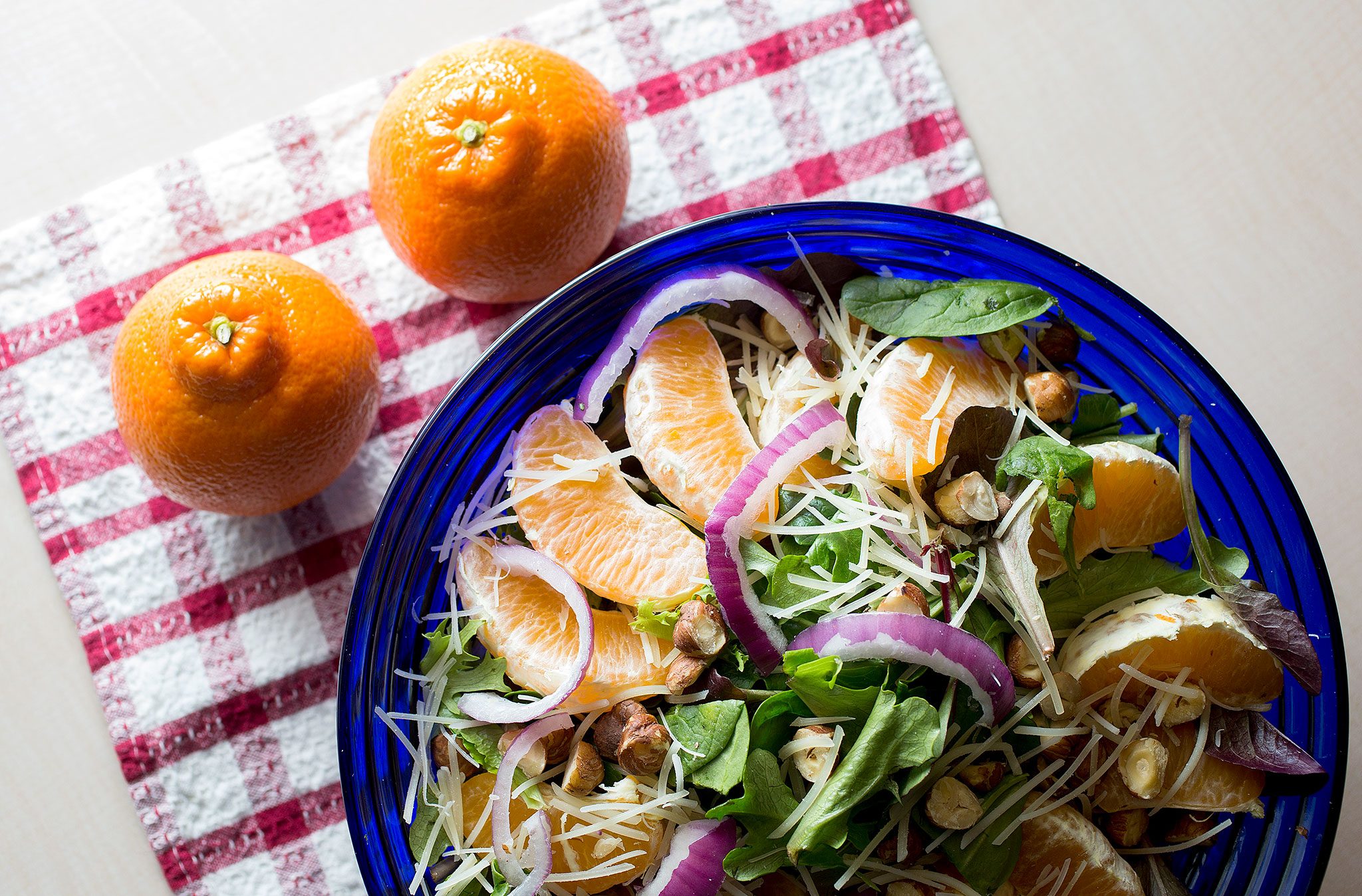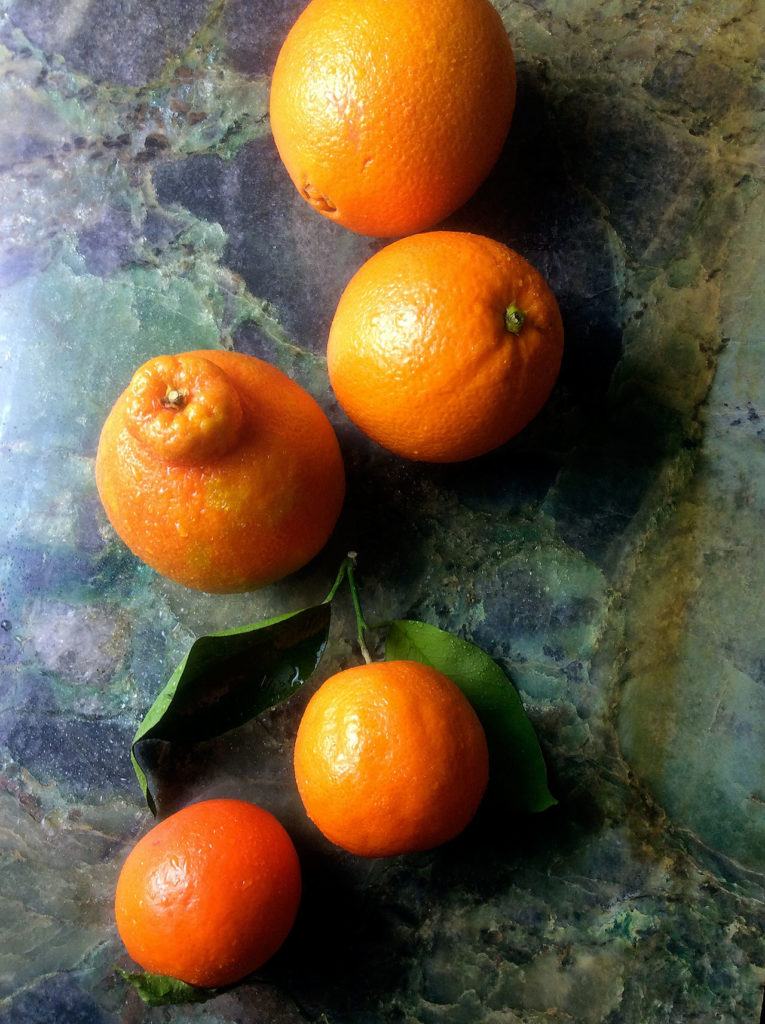There’s something remarkable about peeling back the skin from a fresh orange in the dead of winter. The pent-up tropical fragrance, once released into the atmosphere of a Pacific Northwest kitchen, is a heady reminder that there are places where jackets needn’t be made of fleece, and a rag-top Mustang opens to a January sky that is more turquoise than gray.
Indeed, this is the time of year when those states that can are dealing in the commerce of shippable sunshine — Florida, California, Arizona, Texas.
Because food has become such a global commodity, it’s easy to forget that something as basic as an orange, or a lemon or a tangerine, is just as seasonal as your backyard summer tomatoes. This is their season, so for the next many weeks — into February and March, actually — so now is the time to take advantage of such domestic treasures as juicy-sweet navel oranges, charming little tangerines, ruby red grapefruits and richly aromatic tangelos.
You don’t have to give it much thought. Just bring them into your kitchen and enjoy how they provide healthy variety to your winter-dulled palate.
For instance, have you ever made juice from a bowl of tangelos? I did that once; I juiced about half a dozen tangelos. The flavor was quite different than orange juice; slightly sweeter and much richer. It was quite the treat.
If you are a bit curious about these delightful fruits, start with the common navel orange. Did you ever wonder who put the navel in navel oranges? According to orange historian Vince Moses of Riverside, California, that appearance of a navel on the outside of the orange is the result of a mutation. The mutation, he noted, created a conjoined twin on the developing fruit, just opposite the stem end.
A Presbyterian missionary in the mid-1800s came upon this navel-like orange growing at his monastary in Bahai, Brazil, and thought it unusual. He was further intrigued because, not only did it sport a belly button, but upon peeling and separating the segments within, he discovered the baby orange lurking inside. Plus, it was extremely sweet, with no seeds.
Knowing this was something quite special, the missionary propagated some trees from cuttings of this unique orange and sent a sampling to William Saunders at the U.S. Department of Agriculture in Washington, D.C. In 1873 Saunders sent two starter trees to Eliza Tibbets, a citrus grower in Riverside to see if they would grow.
Those trees produced incredible oranges — larger and more flavorful than any of the citrus of its time — and literally launched the California commercial citrus industry. Today, nearly all of the navel oranges produced in the state are descendants of the trees Tibbets grew.
In celebration of citrus season, here are a few salads that feature this juicy and nutritious winter treat. Feel free to take these recipes and adjust as needed to make them your own.
Tangelo and mixed greens salad with toasted hazelnuts
The toasted hazelnuts add just a bit of smokiness and are the perfect balance to the citrus and red onion in this salad, making for a tasty combination.
1 quart tender, young salad greens
½ cup toasted hazelnuts, coarsely chopped
2 tangelos, peeled and separated into segments
¼ red onion, sliced into thin strips
Tangy tangelo and balsamic dressing (recipe follows)
Shredded Parmesan
In a salad bowl, combine the greens with the hazelnuts and tangelos. Add enough dressing to thoroughly coat the leaves and toss. Add a handful of shredded Parmesan and toss again before serving. Makes 4 servings.
Tangy tangelo and balsamic dressing
¼ cup freshly-squeezed tangelo juice
1 tablespoon balsamic vinegar
1 teaspoon Dijon mustard
1 teaspoon brown sugar
1 teaspoon grated tangelo rind
3-4 tablespoons extra-virgin olive oil
2 tablespoons finely minced green onion
¼ teaspoon salt, heaping
¼ teaspoon freshly ground black pepper, scant
In a small bowl, whisk together the tangelo juice, balsamic vinegar, mustard, brown sugar and tangelo rind. Whisk in the olive oil, green onion, salt and pepper; adjust flavorings and chill until use. Makes about ½ cup of dressing.
Tossed green salad with oranges and tarragon vinaigrette
If you haven’t used tarragon in a while, I think you’ll be pleasantly surprised at what a lovely flavor it adds to salads. And it compliments the spiciness in the arugula very nicely.
2 navel oranges
1 head of Romaine lettuce
½ cup chopped celery
1⁄3 cup chopped green onions
½ cup of baby arugula
½ cup of toasted hazelnuts, walnuts, almonds, pinenuts or pecans
Tarragon vinaigrette (recipe follows)
Optional additions/substitutions: add avocado slices, substitute grapefruit segments for the oranges.
Peel the oranges with a knife, removing all traces of the white pith. Place the oranges on their side and slice into ½-inch rounds. Cut the rounds into quarters.
In a bowl, combine the oranges with the lettuce, celery, green onions, arugula and nuts. Drizzle on enough dressing to thoroughly coat the salad and toss well.
Tarragon vinaigrette
¼ cup tarragon vinegar
2 tablespoons sugar
½ teaspoon Worcestershire sauce
¾ teaspoon salt
¼ teaspoon freshly ground black pepper
Whisk together vinegar, sugar, Worcestershire sauce, salt and pepper. Makes about ½ cup of dressing.
Broccoli salad with tangerine wedges and sesame-poppy seed vinaigrette
I designed the dressing for this salad to go with a recipe for grilled chicken salad with sugar-glazed almonds. Thanks to the toasted sesame seeds in the vinaigrette, there’s a hint of bacon flavor in the salad. It is also delicious in a wide range of salad offerings, including the recipe below for grilled chicken with sugar-glazed almonds. Try it with shredded cabbage with orange wedges, sliced fuyu persimmons and young salad greens, as well as a plethora of baby spinach salad combinations incorporating any number of fruits such as pears, oranges and apples.
3 cups broccoli florets
1 small red onion, sliced into slender rings (or half rings)
2 seedless tangerines, peeled and divided into segments
½ cup golden raisins or dried cranberries
Shredded sharp cheddar or Parmesan
Sesame-poppy seed vinaigrette (recipe follows)
Sesame-poppy seed vinaigrette
¼ cup red or white wine vinegar
1 tablespoon sugar
2 tablespoons lightly toasted sesame seeds,
1 tablespoon poppy seeds
1 tablespoon coarsely chopped onion
½ teaspoon Worcestershire sauce
¼ teaspoon paprika
½ teaspoon salt in a blender or food processor
1⁄3 cup vegetable oil, such as canola
Place the vinegar, sugar, sesame seeds, poppy seeds, onion, Worcestershire sauce, paprika and salt in a blender or food processor. Blend until most of the sesame seeds are ground. (Stop the motor several times and scrape down the sides of the container.) Scrape the contents into a small bowl, then whisk in the vegetable oil in a slow, steady stream. Yields 3/4 cup.
To assemble the salad: Place the broccoli, onion, tangerines, raisins and cheese in a salad bowl. Add enough of the dressing to thoroughly moisten the ingredients and toss well. Add additional dressing as needed.
Grilled chicken salad with sugar-glazed almonds
4 skinned and boned chicken breast halves, grilled and cooled
½ cup sesame and poppy seed vinaigrette (recipe above)
6 cups of salad greens (I prefer to use half Romaine and half young spinach leaves)
2 Roma (Italian-plum) tomatoes, diced
2 ripe Haas avocados, peeled, seeded and diced
½ cup Sugar-Glazed Almonds (recipe follows)
¼ cup minced sweet onion
Salt and pepper to taste
Several leaves of romaine lettuce
2 navel oranges, (peeled with a knife and cut into chunks or rings) for garnish
Additional tomato wedges for garnish
2 hard-cooked eggs, sliced for garnish
Cut the cooled pieces of chicken into ¼-inch pieces and combine with the vinaigrette, salad greens, tomatoes, avocado, almonds and onion. Add more vinaigrette as necessary to reach desired consistency. Salt and pepper to taste.
To serve, arrange romaine lettuce leaves on four plates, then divide the salad mixture between them. Garnish with the pear slices, additional tomato wedges, and the sliced egg.
Sugar-glazed almonds: Place a sheet of waxed paper on the counter. In a non-stick skillet (or skillet sprayed with non-stick vegetable spray), roast ½ cup sliced almonds over medium-high heat until golden, shaking the pan to prevent scorching. Sprinkle on about 2 tablespoons of sugar, stirring constantly with a silicon spatula, and cook until the sugar melts around the almonds. Remove from heat and quickly scrape the almonds onto the sheet of waxed paper to cool. Once cool, break the nuts apart. Yields ½ cup almonds.
Simple salad of oranges, apples and golden pineapple with creamy apricot dressing
You will be amazed by the creamy apricot dressing. So simple, and yet the caramel overtones created just by merging an apricot jam with mayonnaise really makes it a wonderful dressing for all things citrus.
2 navel oranges (or other citrus such as tangerine or tangelo)
2 Fuji apples, peeled, cored, and cut into bite-sized chunks
1 cup golden pineapple chunks (either fresh or frozen)
1 cup sliced celery
Creamy apricot dressing (recipe follows)
Combine oranges, apples, pineapple, and celery in a bowl. Let mingle long enough to become a bit juicy. When ready to serve, divide the salad between 3 salad plates. Drizzle each serving with some of the dressing. Pass additional dressing at the table.
Creamy apricot dressing
½ cup mayonnaise
1 heaping tablespoon apricot jam
In a small bowl, whisk together the mayonnaise and apricot jam. May be prepared several days ahead. Makes ½ cup dressing.
Jan Roberts-Dominguez is a Corvallis food writer, artist and author of “Oregon Hazelnut Country, the Food, the Drink, the Spirit,” and four other cookbooks. Readers can contact her by email at janrd@proaxis.com or obtain additional recipes and food tips on her blog at www.janrd.com.
Talk to us
> Give us your news tips.
> Send us a letter to the editor.
> More Herald contact information.


























